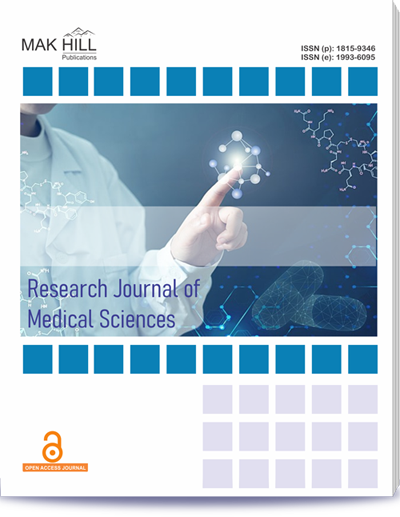
Research Journal of Medical Sciences
ISSN: Online 1993-6095ISSN: Print 1815-9346
Abstract
Nephrotic syndrome (NS) is a significant pediatric kidney disorder characterized by massive proteinuria, hypoalbuminemia and edema, often accompanied by hyperlipidemia. Relapse in NS, defined as the recurrence of proteinuria following remission, can lead to repeated hospitalizations, increased healthcare costs, and a significant impact on the child's quality of life. Identifying the risk factors for relapse is crucial for improving management and outcomes. This prospective observational study was conducted over ten months from October 2020 to July 2021 at Jawaharlal Nehru Medical College and Hospital (JLNMCH), Bhagalpur. A total of 70 children aged 1 to 18 years with a confirmed diagnosis of nephrotic syndrome were enrolled. Data were collected on demographic, clinical, and biochemical characteristics. The study analyzed these data using descriptive statistics, comparative analysis, and logistic regression models to identify independent predictors of relapse. The study population was divided equally into relapsers (n=35) and non‐relapsers (n=35). Relapsers were significantly younger (mean age 5.8 years) compared to non‐relapsers (mean age 7.2 years), with a p‐value of 0.023. A higher percentage of relapsers were male (80%) compared to non‐relapsers (51.4%), with a p‐value of 0.013. Low socioeconomic status, delayed steroid response, respiratory infections, and family history of nephrotic syndrome were significantly more common in relapsers. Biochemical analysis showed that relapsers had lower serum albumin levels (mean 1.9 g/dL vs. 2.3 g/dL, p=0.001) and higher serum cholesterol levels (mean 350 mg/dL vs. 290 mg/dL, p=0.008). Logistic regression identified younger age, male sex, low socioeconomic status, delayed steroid response, respiratory infections, familya history of nephrotic syndrome, lower serum albumin and higher serum cholesterol levels as independent predictors of relapse. The study highlights significant risk factors associated with relapse in childhood nephrotic syndrome, including younger age, male sex, low socioeconomic status, delayed steroid response, respiratory infections, family history of nephrotic syndrome, lower serum albumin and higher serum cholesterol levels. Early identification and targeted management of high‐risk patients are crucial for reducing the frequency of relapses and improving clinical outcomes. These findings underscore the need for a comprehensive and multidisciplinary approach to managing childhood nephrotic syndrome.
How to cite this article:
Vimal Kumar, Satish Kumar, Kishor Kumar Sinha and Ankur Priyadarshi. Study on Risk Factors for Relapse in Childhood Nephrotic Syndrome.
DOI: https://doi.org/10.36478/10.36478/makrjms.2023.12.567.573
URL: https://www.makhillpublications.co/view-article/1815-9346/10.36478/makrjms.2023.12.567.573